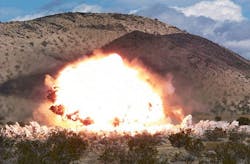Air Force asks L-3 to build C-HOBS radar proximity sensor to trigger air-burst munitions in $131.8 million deal
Officials of the Air Force Life Cycle Management Center at Hill Air Force Base, Utah, are asking the L-3 Space & Sensors-Cincinnati segment in Cincinnati to build the Cockpit-Selectable Height-of-Burst Sensor (C-HOBS).
This new avionics subsystem will replace the now-fielded Northrop Grumman DSU-33D/B height-of-burst sensor, as well as address obsolescence issues. Northrop Grumman has been building the DSU-33D/B sensor since 1999, and recently delivered the 200,000th system.
C-HOBS is a radar proximity sensor that provides high precision variable proximity function to the fuze system. The sensor will provide manual and cockpit-selectable heights of burst, precision height sensing, and possible terrain discrimination.
Related: ATK to provide proximity sensors for fighter-bomber munitions
C-HOBS is a modification program to resolve obsolescence issues with the DSU-33D/B sensor and to improve sensor performance. It will maintain the same form, fit and function as the DSU-33D/B, and will address certain targets of opportunity to future-proof the sensor. Details of the C-HOBS specifications are classified.
Upgrades of the C-HOBS program include manual and cockpit-selectable radar-guided height-of-burst with improved system performance for JDAM and the Next Generation Area Attack Weapons (NGAAW) missions, Air Force officials say. L-3 is expected to build as many as 60,000 C-HOBS units.
On this contract L-3 will do the work in Cincinnati, Ohio, and will be finished by April 2027. For more information contact L-3 space & Sensors-Cincinnati online at https://cinele.com, or the Air Force Life Cycle Management Center-Hill Air Force Base at www.hill.af.mil.
Ready to make a purchase? Search the Military & Aerospace Electronics Buyer's Guide for companies, new products, press releases, and videos


